Travelogue, South Pacific Cruise 3 December 2012 to 8 January 2013 - Part One3 December 2012. Sydney, AustraliaI arrived in Sydney after a 14.5 hour direct flight not having slept much and as I had pre-bought a ship transfer, had to wait for some more pax to arrive before we got a bus through the downtown area to Circular Quay where the Ocean Princess was docked. I had sailed on her before about 4 years ago when she was known as the Tahitian Princess. Her length is 592 feet, her gross tonnage is 30,200 tons, and she can carry 670 passengers, but by my reckoning we are only about 500 or so pax plus about another 300 or so crew. I had about two and a half hours free before our compulsory lifeboat drill, so I walked around Circular Quay, past all the ferry terminals, to the Opera House (you will see a panoramic photo below of her, the ship and the coat hanger aka the Sydney Harbour bridge).  I then walked over to the Royal Botanical Garden, which had a number of interesting plants, including a wattle, some Australian white ibises, some rainbow lorikeets and a couple of kookaburras. The ibises were tagged, the lorikeets and kookaburras were not. 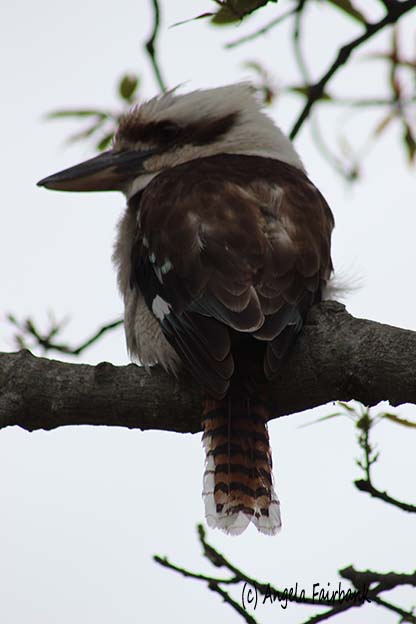 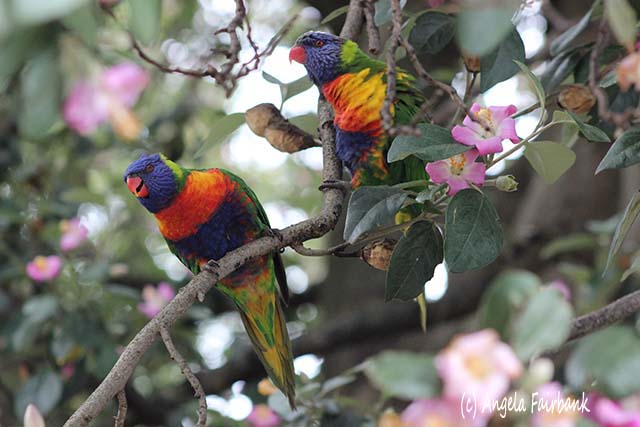 7 December 2012, Tauranga, New ZealandAfter 3 sea days, it was nice to be on land again in Tauranga, a pleasantly situated town on the eastern shore of the North Island, with 67,000 residents and the country's leading export port with its prominent land feature, Mount Mounganui, gateway to the geysers at Rotorua and to kiwi fruit country (though they also raise kiwi birds in this area). I was more interested in the Maori culture than in mud and steam, or seeing how this super fruit is cultivated, so I joined a tour to the Tamaki Maori village which included a delicious lunch including pavlova - which is apparently a New Zealand dessert and not Australian as the Australians would have you believe. The Maoris put on a traditional welcome, which meant that we had to choose a male chief from each of our three respective tour busses to represent our groups, and to exchange spirits with the Maori via the traditional forehead and nose touching gesture after some chanting, singing and warlike gestures (on the part of the Maoris, not us.) We were told not to smile, not to sit, not to crouch down and to be silent as this went on. Luckily though, we were allowed to film and to photograph freely. We then went round their village and were shown different traditions such as wood carving, their war dance (haka), spinning their poi balls around, throwing sticks to each other, and their subterranean oven. I was busy filming so did not volunteer for any of the demonstrations. Can you believe that the New Zealand government banned any sort of traditional Maori behaviour or language from New Zealand for several decades? You will see below photos of two of the Maoris, who after the village demonstrations, put on a singing and dancing show and then served us a wonderful buffet lunch, filled with a lot of speeches (all part of the culture). 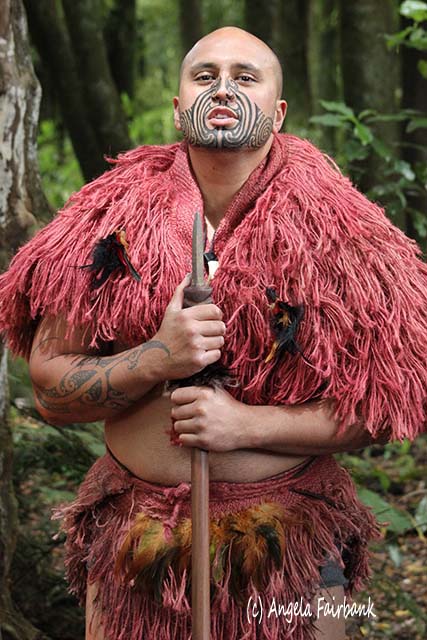 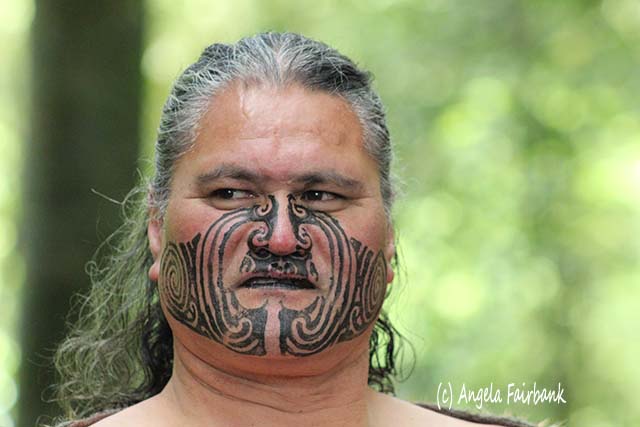 8 December 2012, Aukland, New ZealandWe arrived in Auckland today, which claims to have more boats per capita then anywhere else in the world and has been nicknamed “The City of Sails.” It was the capital from 1842 to 1865 at which time it was moved to Wellington on the South Island as it is more central. Auckland's population is just over 4 million (est. 2007) and its skyline features a Sky Tower, the southern hemisphere s tallest, seen in the photo below. 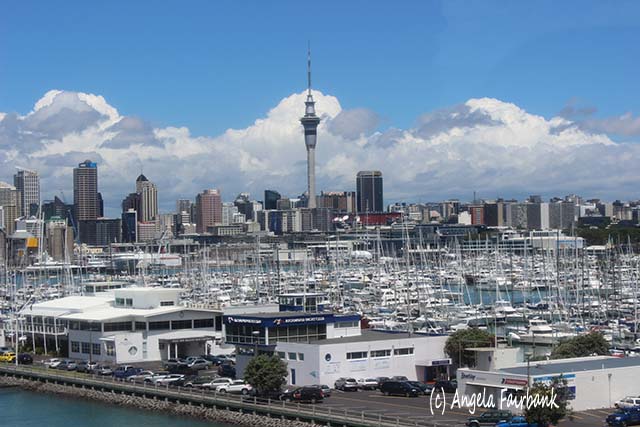 Today I had chosen a tour to a sheep farm and a colony of aeronauts, related I believe to the albatross. The latter, the Murawai Beach Gannet Colony, was our first stop and there were some great vistas of the shoreline. This black sand beach is a paradise for surfers. We took a short uphill walk to a promontory overlooking the spot where the gannets were gathered, some displaying mating rituals but mostly just flying around and nesting. 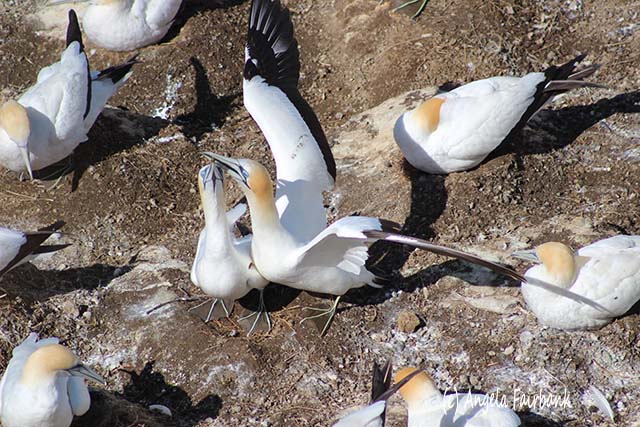 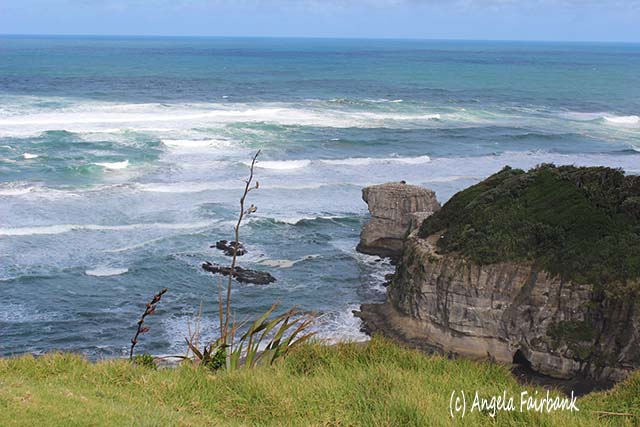  Haumoana Farm was located on the top of the hill and again offered marvellous vistas. Apart from a number of sheep, it was also home to a few cattle and deer. The owner is a butcher so we had fresh lamb as well as venison-and-beef sausages on offer for lunch, in addition to some more pavlova. The two sheep dogs helped to round up the sheep and the neighbouring young farmer sheared one for us. Being springtime, there were a couple of lambs in the fold. Among the deer, a faun had been born about 20 minutes before the arrival of our tour bus. The mother was still licking it and encouraging it to stand where it had been born so as to move it away to a safer distance from us tourists. Below are a few photos of the sheep and deer.   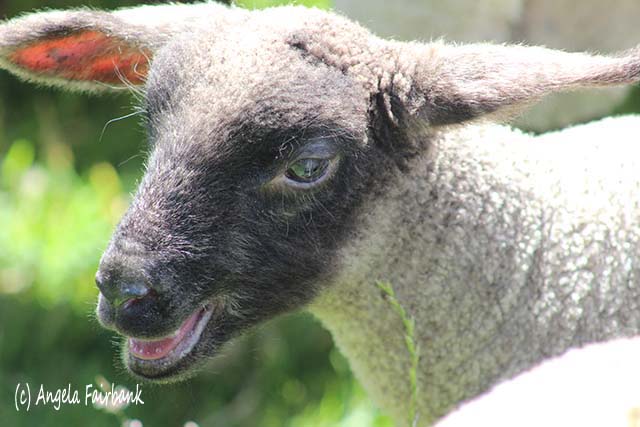 11 December 2012, TongaTwo more sea days later we arrived in Tonga, pronounced, not Ton-ga, as I had been taught, but rather, Tong-a. Its capital city, where our ship docked is Nuku'alofa, and this is where the present King of Tonga lives, his ceremonial royal palace being situated prominently on the seafront. His father recently died - in March 2012 - so his family is still in mourning, probably will be for the rest of the year, at the end of which time, the new king will be crowned. The rest of the country was in mourning for 3 months only. There are nonetheless purple and black banners on the walls of various properties around the town, and I had to ask whether this was in fact still to show mourning for the king, or for the Christian Advent, which also uses purple. I was assured that it was for the late king. Talking of advent, one of the first buildings I stepped into was an Anglican church and I met the deacon, or was it the dean?, Joe, a local Tongan and his Kiwi wife of 41 years, Anne. They had been married in that very church, but had lived for some time in New Zealand before coming back to Tonga earlier this year to take up the charge of the parish. Their church was also dressed for Advent, in purple, but Joe apologised that the candles were white as they had no purple candles in all of Tonga! There are four Anglican churches in Tonga, a number of Catholic churches - two of which I visited as well as a Tongan traditional type church, inside of which a very important-looking meeting was taking place with all male elders, all dressed up in suits, despite the very muggy climate - and a large number of Seventh Day Adventist churches, which also looked after much of the schooling. For university studies, Tongans must go to Fiji. The Tongans on the street were very friendly and all of them were saying hello to us. They only get about one cruise ship in six weeks or so during the tourist season. The Tongan males traditionally wear a sort of woven grass skirt made of pandanas leaves or banana leaves or palm fronds, I would guess, while the women wear more of a belt made of similar materials. All had their knees covered (as we were advised to do in respect of their traditions). You will see below examples of the male and female traditional dress. The woman is Lavinia, our tour guide, and the male is our driver, whose name I did not get. The boy in the middle was like most children around the world, in Western clothing, though the hat was unusual!  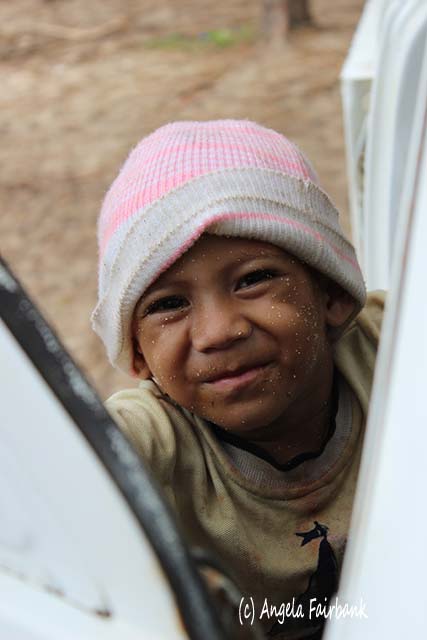 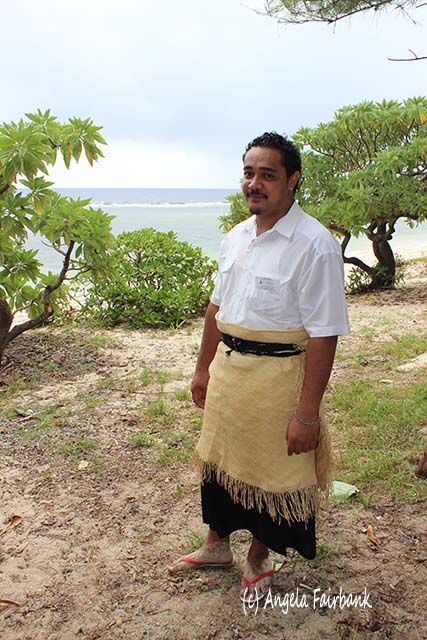 Lavinia had studied for three years in Fiji and majored in Linguistics, not, as I surmised, in the linguistics of Romance languages as I had dabbled in, but in Polynesian languages. She told me that the Tongan language most closely resembled the language of Wallis and Futuna Islands. She had also studied French in high school so practiced it with me. She is 20 and like most recent university graduates around the world is looking for work. Tourism, as the number of visitors to Tonga is not very high, is just a part-time, temporary job for her. This was only the second time she had taken a group of tourists to this particular snorkelling spot, and unluckily for us, the fish life was very sparse that day, only a few blue neons and some black fish, so it was a bit of a let down. Higher up on the beach where she took us, there was a number of very decorative recent tombs, ringed in their traditional way with empty, upside down, beer bottles. One way of recycling bottles I suppose. However, in town I saw a number of wire cages i.e. recycling bins for used pop cans. On the way back to the ship I met four older teenagers, all of whom were wearing the male type of traditional skirt, so I asked if they were coming to the wharf to give us a cultural dance display, but no, they had just attended a funeral, hence their black vestments. The other two photos below are of vegetables found in their main market and some men playing checkers just outside the market. 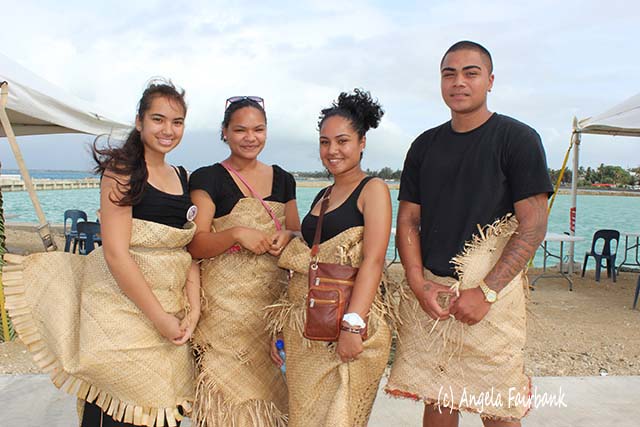  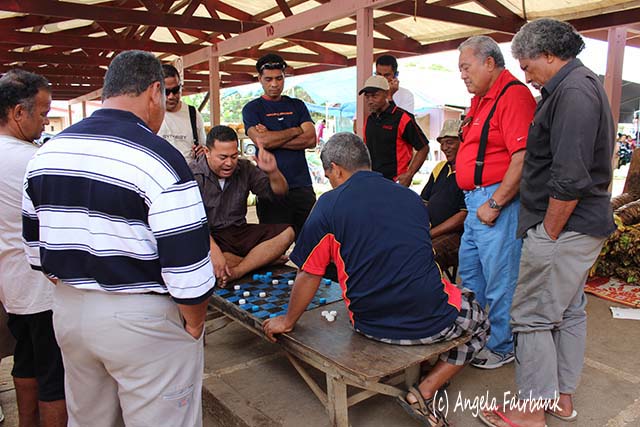 12 December 2012, At SeaAt about 7:45 am the Captain's voice came into our cabins to tell us that according to the satellites, a tropical storm of cyclonic proportions, called Evan, was encroaching on Samoa and American Samoa, so he had decided to divert our course. Instead of Apia (formerly Western Samoa, now known as Samoa on December 13th east of the International Dateline, and Pago Pago (pronounced Pango Pango) in American Samoa on December 13th west of the International dateline, our original itinerary, we would now have two more days at sea and then arrive in Raiatea on the 14th and Huahine on the 15th, both part of French Polynesia. French Polynesia, situated in a depression, I learned later, is not susceptible to cyclones.
The captain frequently kept us abreast of cyclone Evan, which later moved on to Fiji, and the day we would have arrived, Samoa was flooded, the airport was closed, 7 people were injured and 3 died, two of which were children who drowned. It was the worst storm they had had for 21 years. 14 December 2012, Raiatea, French PolynesiaWe arrived in Raiatea, after a couple of rough days at sea and rain, to sunshine and clear skies. I had booked a tour to a pearl farm which included snorkelling. It was, once again, good to be back on land, and I watched the berthing where several people dressed in pareos and wearing floral crowns watched us come in. We were now in French territory so both the French tri-couleur and the French Polynesian flag, designed by a Chinese man, were displayed on our ship's flag poles. Our driver out to the pearl farm was named Nila and she asked me if I liked mangos. I told her they were my favourite fruit. Apparently there are several dozens of different types of mangos and being the season of abundance, as they call it here, the island was prolific with them. However, there are some anomalies, as she told me that apples, which are not native to the islands, cost less here than pineapples, which are. I asked her for a price comparison, and she said that she could buy 10 apples for the price of one pineapple. I then asked her what the price of gasoline was but she didn't know as apparently she had never had to fill up the tank of the van she used for her job to transport us to the pearl farm. She told me that she had moved from Huahine to Raiatea for work and all her family still lived on Huahine. Of all the islands in French Polynesia, she said she liked Huahine the best as it was the quietest. The worst of the Society islands archipelago in her opinion was Tahiti, as she said it was filled with cars and pollution and that all the people living there were stressed. She also told me that the meaning of Huahine in Polynesian language, means literally “woman sex” - Hine meaning woman and Hua meaning sex. Someone else told me it actually meant the female sexual organ. Another (male) tour guide on Huahine said that it meant “paradise for men” (well, there were children present at the time). Since then, I have heard it frequently translated as “pregnant woman,” as the shape of the island resembles a pregnant woman lying on her back. But I digress. After about a 30 minute drive we were met by Summer - a young American woman from California who had fallen in love with a Polynesian man while here a few years ago, had married him and now has two children with him and has picked up pretty good French - and Ronny, a pearl grafter, who was driving the boat, They took the 5 of us - myself, a young honeymoon couple from Australia and two young girls who work on the ship at the spa, one from Vietnam, the other, Dianne, from Trinidad - out to the pearl farm located over the water. Here they cultivate black pearls, mainly for the Japanese market. There are apparently 5 pearl farms in Raiatea though there used to be 10. During the explanation of how pearls are made, Ronny inserted a nucleus into a virgin oyster and removed some nice looking pearls from about 5 others, re-introducing a slightly larger nucleus to each. An oyster can make about 4 pearls in its lifetime. It is strung on a string with a half dozen or so other oysters and hung in the water over about 4000 acres (I think Summer said) of area and each string is dated so their growth can be monitored and checked so that they know when to remove the pearls and insert larger nuclei. The colour of the pearls depends on the colour of the shell. Well this is the simplest explanation. 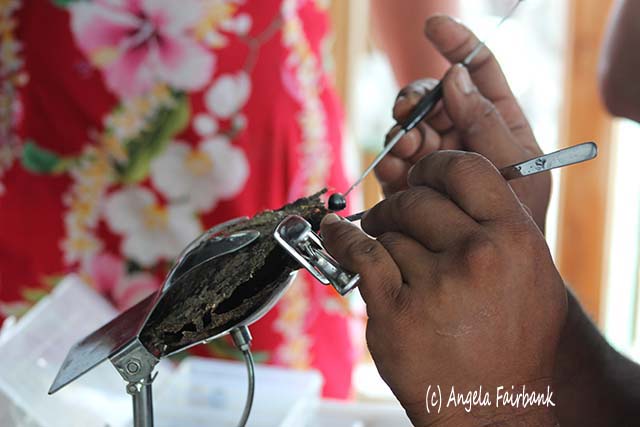  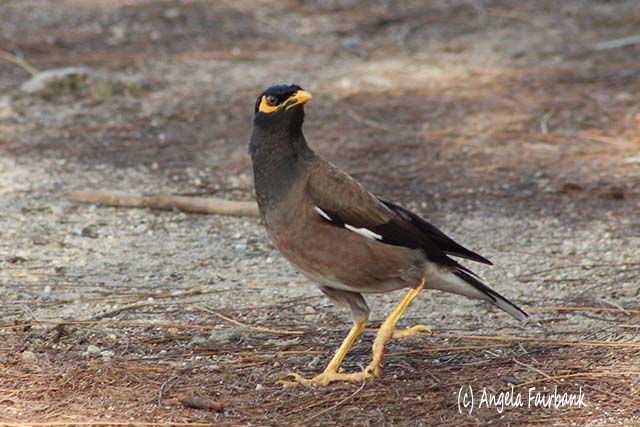 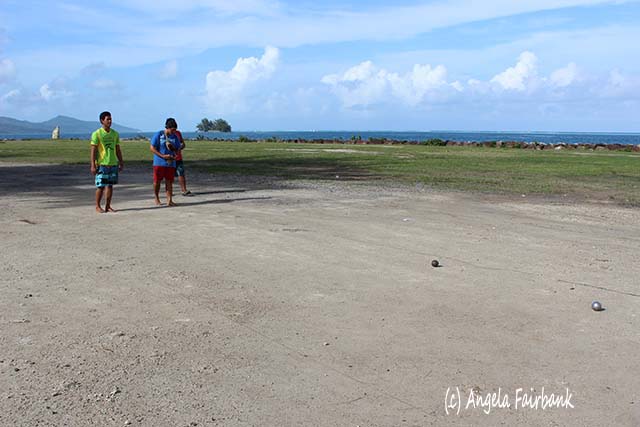 After the presentation and offers of coconut flesh, pomelo sections and passion fruit halves, we had about a half hour or so to don our snorkelling gear and take a look at all the large fish swimming in these oyster beds - including sergeant majors, angel fish, bright yellow ones and blue neons, a parrot fish - quite a diversity not to mention the very colourful coral, and we were in relatively deep water out near the reef. En route back to the shore, Ronny and Summer drove us out to the reef where there was a lone shark (I originally wrote a “loan shark”) swimming parallel to the breaking waves, but all we could really see of him (or her) was his/her yellow and black striped dorsal fin. When Nila picked us up to take us back to the wharf, she had a bag for me - two large mangos, which I consumed at a couple of breakfasts a few days later! Delicious! I went on a bit of a walk round town, and apart from people and flowers, photographed some ubiquitous Indian myna birds (right above) and brown boobies (middle above) and a game of boules (pétanque). However, I was anxious to get back on board as we were having a presentation of dancing from a group called “The children of Raiatea” who, as you see below, were very cute! The youngest, on the left, is 3 years old. 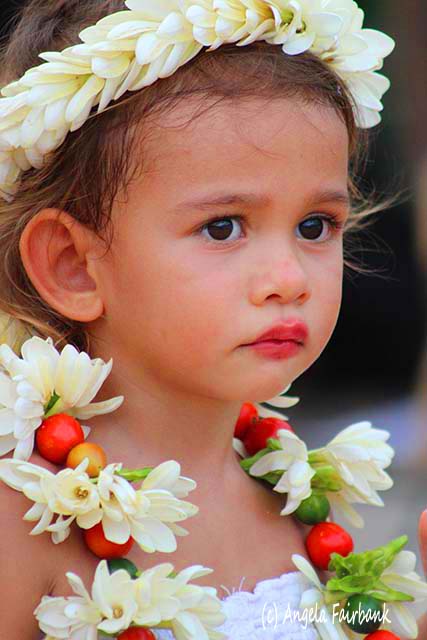 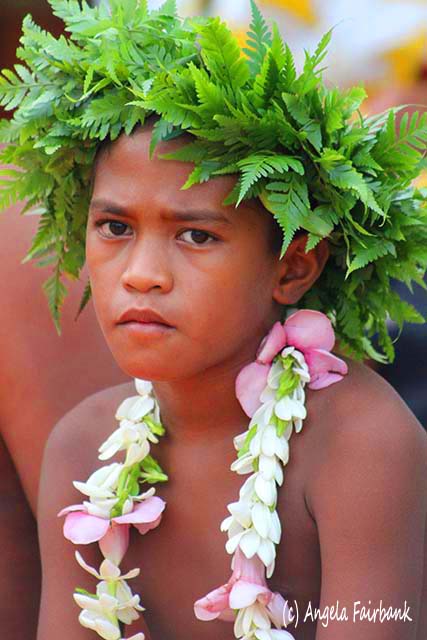 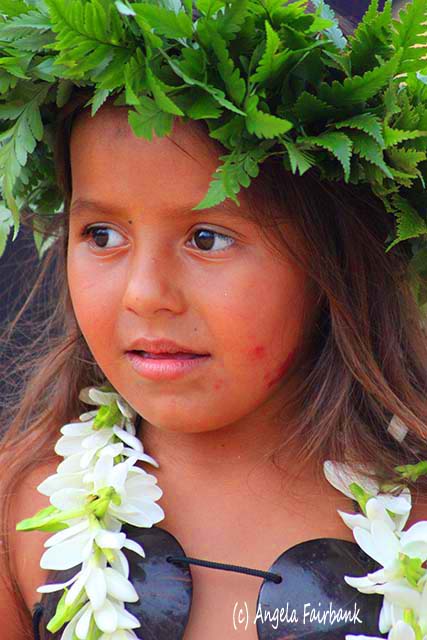 15 December 2012, Huahine, French PolynesiaIn Huahine, (pronounced Hwa-'hee-nay) I had booked an outrigger canoe trip to white sand Hana Iti beach with opportunities for swimming and snorkelling. There was nothing much else to do and limited places to walk, so I photographed what I could of flora and fauna - a few crabs, Chinese pagoda flower, yellow hibiscus. I did later learn that this ubiquitous hibiscus tree (Hibiscus tiliaceus) is used for many products: e.g. from the bark, they make their grass skirts for dancing, from the wood they make their ukuleles and their outrigger canoes. Being a very light wood, it has enabled French Polynesia to win many outrigger canoe races in the Polynesian world. The flower opens in the morning yellow and by the evening it has changed to a reddish-pink colour and falls off. The part of the island where the beach was used to have a very good restaurant on it - now closed, abandoned and falling into decay. We were told that it used to belong to the brother of Julio Iglesias. The trip was hosted, and the outrigger was driven, by Parka who played us his ukulele, which he had made himself from the aforementioned hibiscus wood. It was tuned slightly differently from the ukuleles I was used to: instead of G above middle C, middle C, E above middle C and A above middle C, it was E above middle C, middle C, G below middle C and A below middle C, so same notes, different octaves and different order. As the sun was hot and we were provided with chairs, we sat on the edge of the sand with the shadow of palm trees over us and our feet in the clear warm water. I went out snorkelling for about 1/2 an hour and was most impressed by the number of very large, dangerous, spiky, sea urchins. Otherwise, the number of fish was not numerous. Slightly bored, I approached Parka and his colleague, Heimana, for explanations of their respective tattoos (mostly based on designs from nature) and they agreed to be interviewed on film. Tourism is not big in this island, and Heimana had essentially got this job because his wife's father owns the business. Hei-mana means crown of power: Hei = crown; Mana = power, strength, spirit. He told me that when there are no tourists, they manage to survive. But you don't need much to survive on these islands, breadfruit, bananas, mangos, avocados, pineapples, etc. all grow abundantly so you won't starve, unless you are extremely lazy. Below are photos of the outrigger that brought us to the beach (middle), Heimana (left) and Parka (right) as well as another fellow in his own outrigger canoe who was riding the wash of our tender boat.   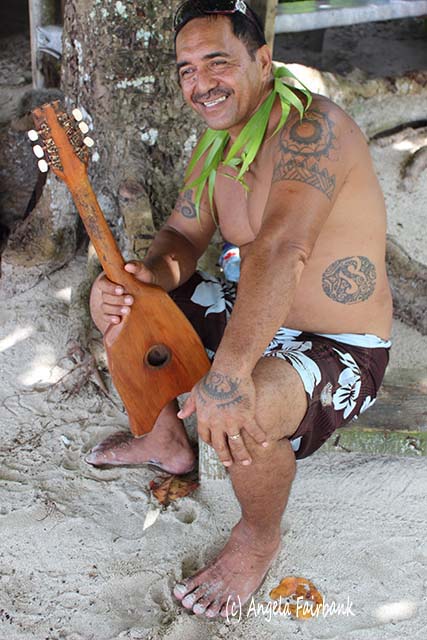  Huahine is divided into Huahine Nui (big Huahine) and Huahine Iti (small Huahine) and in the afternoon I took the shuttle bus, known as “le truck” and used habitually to transport school children, into the main town, Fare (which means “house”), but it was relatively quiet and nothing much was happening. I walked through the grounds of one hotel with its public beach, and past a few retail stores, owned by Chinese families but most people were gathered round watching a weight-lifting competition. Sadly, it was not the traditional type where men and women lift large stones of up to 300 kgs, but rather weights you see in our own fitness centres, so I did not bother filming it. 16 December 2012, Bora Bora, French PolynesiaWe arrived by tender boat in Bora Bora and the girl in yellow in the below photo met us at the wharf as we arrived and handed us each a Tiare flower (Gardenia tahitiensis), which is indigenous to French Polynesia and the national flower. Men and women alike wear it behind the ear. It is white and has six, seven or eight petals.  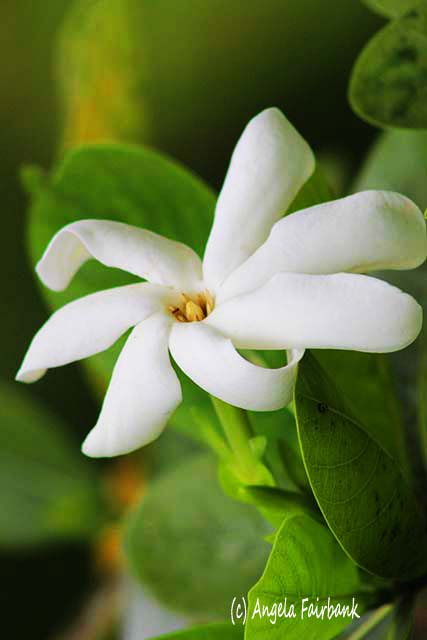 My chosen tour today was a helmet dive provided by a French outfit, Aqua Safari. All the personnel on the dive boat was white French, Daniel our main guide and boat driver, two scuba divers - one a woman and the other a male photographer - and another guy whose name I did not get but who was originally from Saint Raphael in the Côte d'Azur and had been out here for 4 years only. The helmet in question is a 30 kg device with three glass sides which fits over your head and shoulders. Fresh oxygen is pumped into it from a tube attached to your helmet at one end and to oxygen tanks on the boat at the other. We were made to sign waivers before commencing the safari as it is not suitable for people with ear problems, lung problems or heart problems, though if you are fit, it can be enjoyed by people from age 7 to 75, according to their promotional material. The main attraction for me was that I could even wear my glasses, so I would actually be able to see underwater clearly for once and not have to rely on my camera(s) to see for me. And for those with hair issues, your hair doesn't get wet either. For someone who has done a fair bit of snorkelling with not particularly great results, but never been scuba diving, this type of underwater safari was pretty amazing. I had a smile on my face the entire time we were about 12 feet down. There were 14 of us on the trip so we went down in two shifts having about a 1/2 hour for each shift. I opted to go on the second shift so I could photograph and film the others going down. The sea was a bit rocky so this wasn't easy mind you. There were actually eight that went down the first shift, which left us with six. One woman (from Coquitlam), began to feel seasick from the rocking motion of the boat, so she opted out. Another decided she had ear problems so she opted out. The husband of the seasick-feeling woman stayed down for only a short time, and I don't know what happened to the sixth, perhaps he never attempted the descent, or had second thoughts while he was on the ladder. As I was the first to go down I was not aware of his reason. So it was Robyn from the Gold Coast, Australia, and I who had the most time below and the scuba diver/photographer was taking masses of photos of us. I had both of my underwater cameras on, but stopped working as we must have actually been lower than the 10 feet underwater it purported to be able to film at, and the other, which was strapped to my chest, I could not see due to the helmet, so I could not tell if it was filming or not. It also seems to have stopped after a short film clip but it was not aimed, unfortunately at where all the action was, which was right in front of my face, because attached to the helmet was a nylon bag and in the nylon bag was a chunk of French bread. The fish, and there were dozens of them, many species, very colourful, and large ones too, were all feeding from the tiny holes in the bag. The photographer then lured me away to the edge of the area which had been roped off for the dive to a coral on which there was a Nemo-like fish swimming over the suction-like feelers and he indicated, by physically bending my sunburnt legs, that he wanted me to crouch down in front of this live suction-like coral and fish and actually touch the suckers with my fingers so he could photograph me. He also encouraged us to touch the fish in front of us, later handing me a dead clam shell filled with a further chunk of French bread once the medium-size sack was consumed so we could continue to feed the fish. A sting ray was also in the area, though it was not feeding from the French bread and the scuba diver was touching it and indicating its mouth and teeth to us and mimed that we should be careful of its tail as it could sting us. At one point I felt a little nip on my left shoulder, I turned around thinking it was the photographer again, wanting to show me something else, but no, it was just a fish - about medium-sized. When we finally climbed up the stairs to the boat again, all the rest of the passengers, those from the first shift and those that had opted out of the second or had decided to spend only a short time below, had been driven back to the wharf, so it was still just Robyn and me. It was at that point where we were told they had about 80 photos to sell us on a USB drive of all the group down below for $50 or 40 Euros (4000 Polynesian francs). I decided that I would rely on what my cameras took (not knowing then that the smaller Kodak sports camera had died). So, as we spend three more days in Bora Bora on this cruise, I shall sign up for this tour once again and this time make sure my camera is better placed - not on my chest where I can't see it, but on my forehead, as that was where all the activity was taking place. I may also decide to purchase a smaller underwater still camera (they sell them on board) to take some stills of the amazing fish. We shall see. But definitely, this was the best underwater tour I had taken so far. It was a pity it was such a short time and that my cameras were not working properly. I never found out from the Coquitlam couple or from Robyn how the photos turned out. We were nearing the end of this particular leg of the cruise, so when I met the Coquitlam couple again, the man said he had already packed the USB drive into his suitcase and had not had the chance to look at the photos on his computer to see if they were any good. So I do not have stills of this helmet dive aqua safari, but the photos below are from Bora Bora. It was a Sunday so the town through which I walked after the dive was extremely quiet. It was also overcast (though it did not rain). 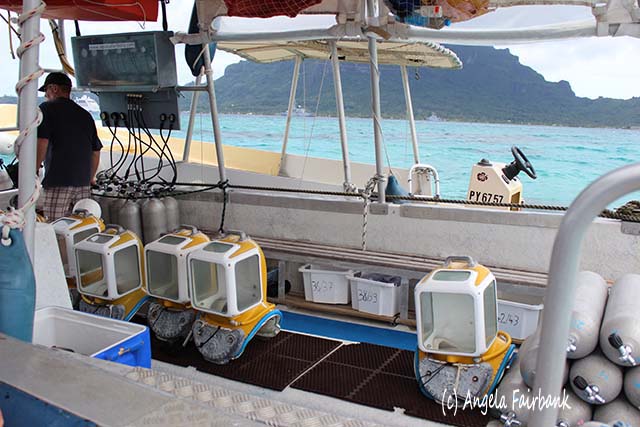  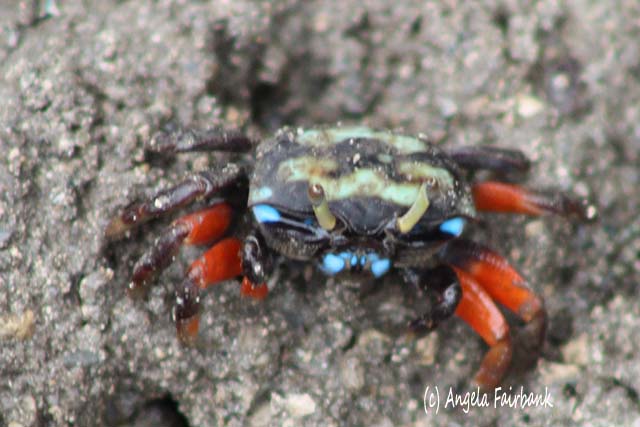 17 December 2012, Moorea, French Polynesia Today's island was Moorea and we met the first of the rain. My tour was a bus trip round the island with stops at several places, all hosted by an amusing bus driver cum guide called something extremely polysyllabic, but he asked us to call him Joe. He said it was his first time giving the tour (not true) and that he had just got his driver's licence yesterday (also not true) and he also said that the population of Moorea was 7000, but according to my 1997 Lonely Planet at that time it was 11,000 and the onboard ship guide mentioned 18,000. So who knows for sure? Perhaps he meant 17,000. He also said many other things some of which were probably true. I retained the following interesting bits, at least.  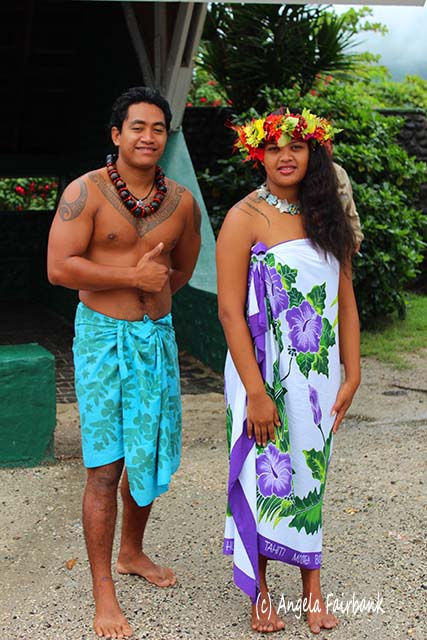 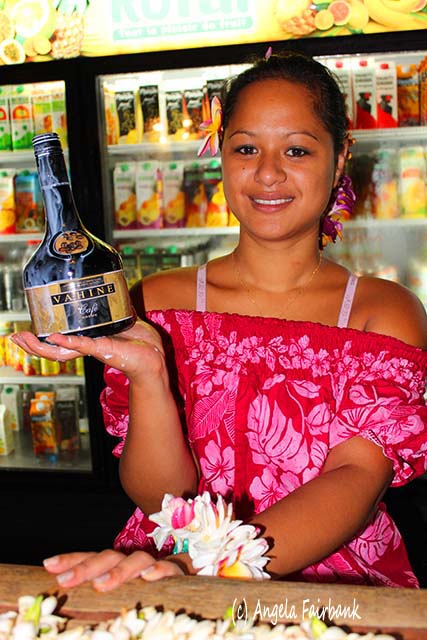 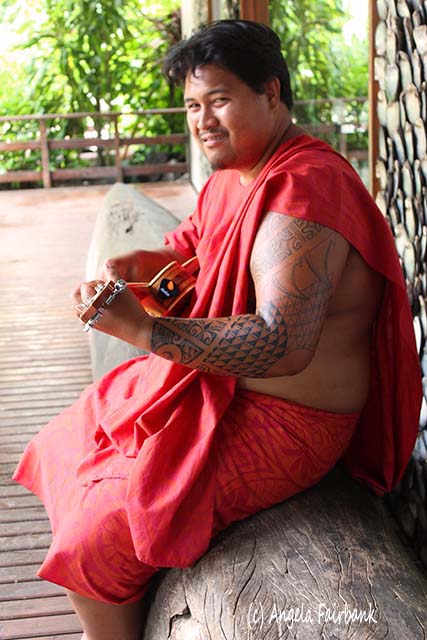 1. For whatever number the population of the island is, there are only 10 policemen, so crime is pretty low. 2. There is a public bus that circles the island of Moorea twice a day. If someone wants to be picked up by the bus, and if it is raining hard and they do not want to wait out in the rain, they just lay some flowers in the road in front of their house to indicate that they want to bus to pick them up. The bus driver sees the flowers, stops, toots his horn and the person comes of out the house and gets into the bus. 3. At church, instead of using bread and wine to signify the body and blood of Christ, they use breadfruit and coconut water. 4. There are elementary, middle and high schools on the island, but if someone wants to study to become a doctor, a lawyer, an engineer or a computer technician, the government will pay for him/her to study in France for the full seven years. If the student passes all his/her exams and works in his/her chosen profession in French Polynesia for 10 years, s/he owes the government nothing. If, however, s/he either fails the exams or passes them but does not return to French Polynesia to work in his/her chosen profession for 10 years, then s/he will owe 100 percent of these tuition expenses to the French Polynesian government.  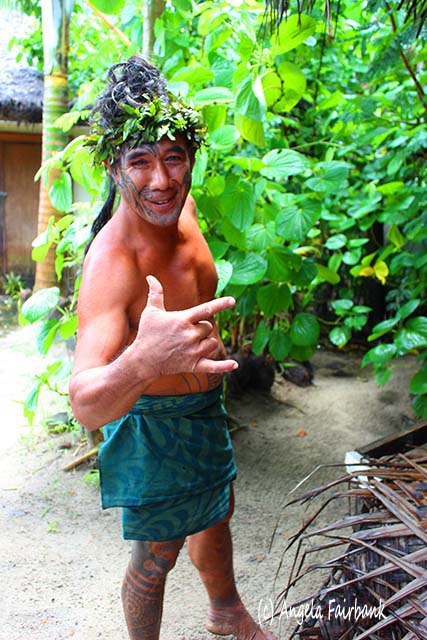   On the whole, the tour was rather disappointing. The first stop was a juice factory where they also make alcoholic drinks. We were given three beverages to sample (two of which were alcoholic, one 8% alcohol the other 17% and it was only about 9 am in the morning!) There was also a shop there for people to buy juice, alcohols and other souvenirs. Then there were a couple of lookouts but visibility was poor due to the rain so they were a bit of a washout. Then there was a stop at a pearl shop - so more shopping. Then finally, and the reason why I had taken the tour - we stopped at the Tiki theatre for a presentation of Polynesian dances. Once more we were cheated as for some reason they are not open on Sunday and Monday and today being Monday they had only opened because we were coming. So the part of the village where they present their traditions and arts and crafts was not operating. However, their pearl shop was open as was their handicrafts shop! Moreover, the amount of dances they presented to us were cut short. Luckily, the rain stopped during the dances, but we were all under cover anyway. As for the people you see in the photos, the first two photos were taken at the tender wharf, the third one is of the lady at the juice factory who was pouring us the free samples and the other five are from the Tiki theatre. The pearl farm you see was in the water at the Tiki theatre and the dogs were playing in the puddles of water at the tender wharf.  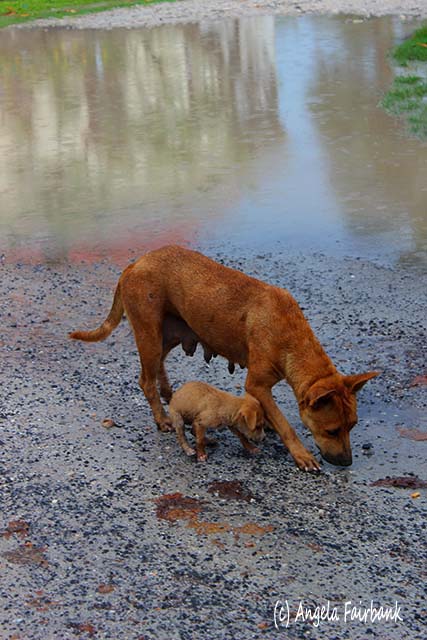 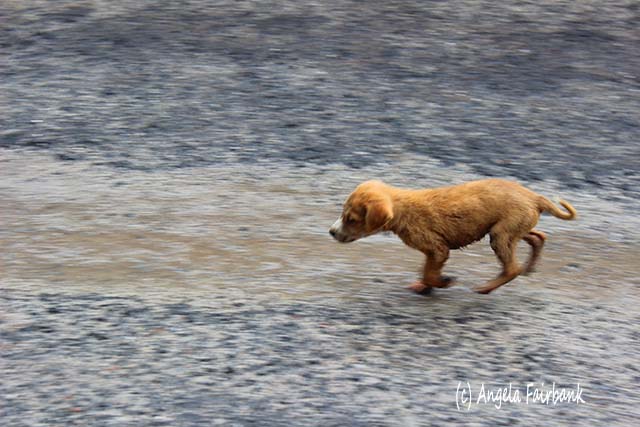 18 December 2012, Pape'ete, Tahiti, French PolynesiaThe first leg of this cruise ended in Pape'ete, Tahiti and we stayed docked here for two nights and two days. The first day it rained continuously, but I did wander into town in the afternoon to visit the market and the town hall but nothing of particular interest happened today so I will end this page here. Continue to Part Two of this cruise. |
Website © Angela Fairbank 2005-2024.
|
